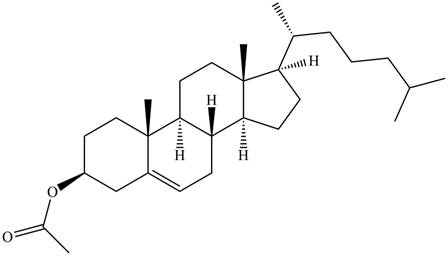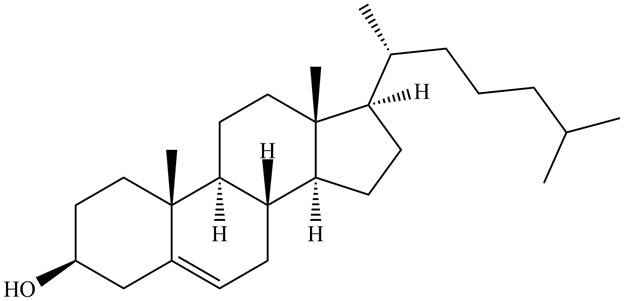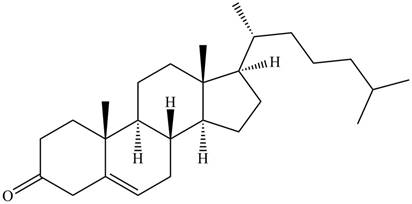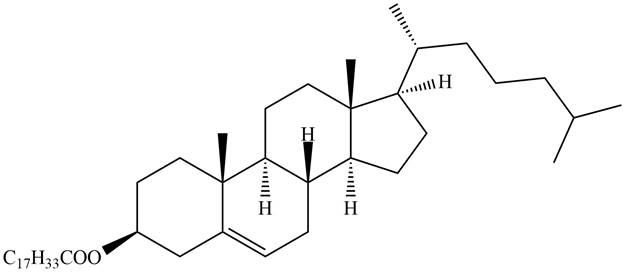
Concept explainers
Draw the products formed when cholesterol is treated with each reagent. Indicate the stereochemistry around any stereogenic centers in the product.
a.
b.
c. PCC
d. oleic acid,
e. [1]
(a)
Interpretation: The product formed on treatment of cholesterol with
Concept introduction: In the presence of base, the hydroxyl group loses its proton to form alkoxide. The alkoxide attacks on the carbonyl carbon of acyl chloride or anhydride to leading to the formation of acyl group and removal of chloride. This process is known as acylation.
Answer to Problem 31.38P
The product formed on treatment of cholesterol with

Figure 1
Explanation of Solution
In presence of base and acetyl chloride, the hydroxyl group of cholesterol undergoes acetylation. The corresponding chemical reaction is shown below.

Figure 2
The product formed on treatment of cholesterol with
(b)
Interpretation: The product formed on treatment of cholesterol with
Concept introduction: The addition of
Answer to Problem 31.38P
The product formed on treatment of cholesterol with

Figure 3
Explanation of Solution
In presence

Figure 4
The product formed on treatment of cholesterol with
(c)
Interpretation: The product formed on treatment of cholesterol with PCC is to be predicted.
Concept introduction: Alcohols are oxidized to different carbonyl compounds depending upon the reagents and alcohol used. In presence of strong oxidizing reagents such as
Answer to Problem 31.38P
The product formed on treatment of cholesterol with PCC is,

Figure 5
Explanation of Solution
On treatment of cholesterol with PCC, the secondary alcohol is oxidized to ketone. The corresponding chemical reaction is given below

Figure 6
The product formed on treatment of cholesterol with PCC is shown in Figure 5.
(d)
Interpretation: The product formed on treatment of cholesterol with oleic acid,
Concept introduction: In presence of acid, the carboxylic acids are converted to ester using alcohols. This process is known as esterification.
Answer to Problem 31.38P
The product formed on treatment of cholesterol with oleic acid,

Figure 7
Explanation of Solution
In the presence of acid, the hydroxyl group of cholesterol reacts with oleic acid to form ester. The corresponding chemical reaction is shown below.

Figure 8
The product formed on treatment of cholesterol with oleic acid,
(e)
Interpretation: The product formed on treatment of cholesterol with 1.
Concept introduction: In the presence of borane, hydroperoxide and base the alkenes are converted to alcohols. In this reaction hydrogen atom and hydroxyl groups are added to the double bond. This reaction takes place in anti-markovnikov addition manner. This is a syn addition.
Answer to Problem 31.38P
The product formed on treatment of cholesterol with 1.

Figure 9
Explanation of Solution
In the presence of borane, hydroperoxide and base the double bond of cholesterol is oxidized to alcohol. The corresponding chemical reaction is shown below.

Figure 10
The product formed on treatment of cholesterol with 1.
Want to see more full solutions like this?
Chapter 31 Solutions
Organic Chemistry
- Draw the products formed when CH;CH2CH2CH2OTS is treated with each reagent. а. СH3SH b. NaOCH,CH3 c. NAOH d. KOC(CHa)3arrow_forwardOH conc H3PO4 A A MCPBA CH₂Cl₂ B NaOH H₂O 8. Identify the products A,B and C.arrow_forwardWhich is a thiol? CH3 HS SH b. HO. CH3 H.CS CHa CH C. H. d. భిగింగడి 工 a.arrow_forward
- Determine the products of each carboxylic acid reaction. a. CH3-CH -C-OH + NaOH b. CH;-CH2-CH;-C-OH + CH — CH, —Сн, — онarrow_forwardDraw the products of each reaction. OH он CH3 Cl2 FeCla Cl2 a. b. С. FeCl,arrow_forwardDraw the organic product(s) formed when CH3CH2CH2OH is treated with each reagent. a.H2SO4 b.NaH c.HCl + ZnCl2 d.HBr e.SOCl2, pyridine f.PBr3 g.TsCl, pyridine h. [1] NaH; [2] CH3CH2Br [1] i.TsCl, pyridine; [2] NaSH j.POCl3, pyridinearrow_forward
- Maltose is a carbohydrate present in malt, the liquid obtained from barley and other grains. Although maltose has numerous functional groups, its reactions are explained by the same principles we have already encountered.a. Label the acetal and hemiacetal carbons.b. What products are formed when maltose is treated with each of these reagents: [1] H3O+; [2] CH3OH and HCl; [3] excess NaH, then excess CH3I?c. Draw the products formed when the compound formed in Reaction [3] of part (b) is treated with aqueous acid.The reactions in parts (b) and (c) are used to determine structural features of carbohydrates like maltose.arrow_forwardDetermine the product formed when butanone (CH3CH,COCH3) Is treated with each reagent. If no reaction occurs, label the reaction with "no reaction". PCC H2 Pd-C HO OH NazCr,O, H,SO.H,O [1] LIAIH, [2] H,O no reaction Ag20 NH,OH NABH, CH;OH Resetarrow_forwardDraw the products formed when a-D-gulose is treated with each reagent. a. CH3I, Ag,0 b. CH,OH, HCI c. CeHsCH2CI, Ag20 d. CgHsCH2OH, HCI e. Ac20, pyridine f. CeHsCOCI, pyridine g. The product in (a), then H3O* h. The product in (b), then Ac,0, pyridine i. The product in (g), then CeHsCH2CI, Ag20 j. The product in (d), then CH3I, Ag20 но OH но OH OH D-gulosearrow_forward
- Q#7 Draw the organic products formed in each reaction. Br -OC(CH3)3 -OCH,CH3 b. CI CI NH2 (2 equiv) Br DBU d. -Oc(CH3)3 Br Br CH3CH2OH f. 1. a. C. e.arrow_forwardDraw the products formed when CH3CH2C ≡ C−Na+reacts with each compound. a. CH3CH2CH2Brb. (CH3)2CHCH2CH2Clc. (CH3CH2)3CCld. BrCH2CH2CH2CH2OHe. ethylene oxide followed by H2Of. propene oxide followed by H2Oarrow_forwardBr H3CO LOCH3 A MgBr 1. CH3OH (2 equiv), H+ 2. Mg 3. 4. H30+ H3COOCH3 в ОН major organic product? НО. OH C OH D ОНarrow_forward
